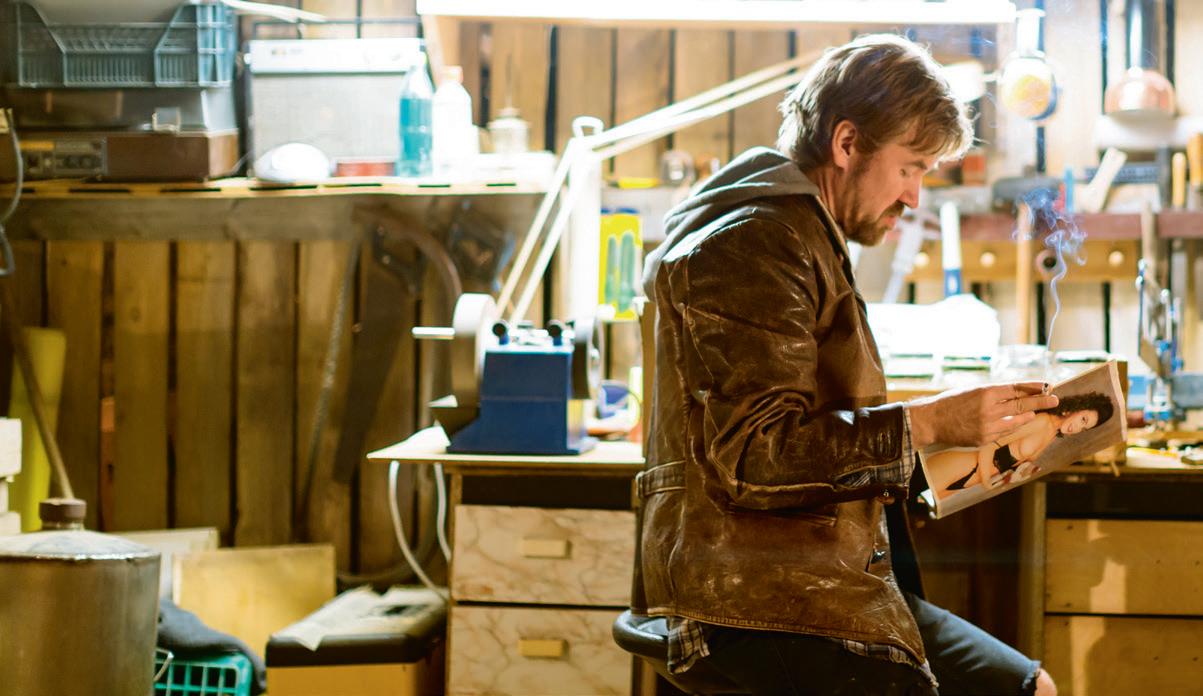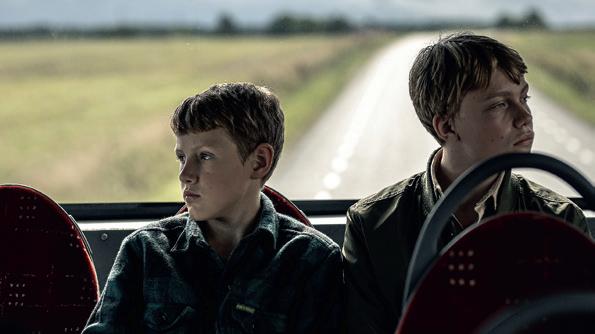
8 minute read
REVIEW The Last Ones


On the Big Screen What Actually Happens?
What actually happens? This question has bothered many. True, we can see bits and pieces with our own eyes, but beyond the fi eld of vision there are some dark forces at work that remain out of reach.
Although today’s society thrives towards “transparency”, it is clear however that more and more important things are happening covertly, hidden from us; many of those can’t be seen with the common eye and others are concealed because they couldn’t be taking place otherwise. Remaining invisible is often a crucial element of the event – and sometimes the essential part of it, because in a visible form it wouldn’t be the same even any longer.
If we were able to see the Earth’s atmosphere heating up, contaminants permeating our air, water and food, the sixth wave of extinction and the destruction of our living environment on every level, we would be left with only two







The Last Ones
By Hasso Krull First published in Teater. Muusika. Kino

options: put a rope around your neck right this minute, or try to do something about the destruction, whatever it takes. Except we don’t see it. We cannot see the last events that our civilization has become so tangled in.
Veiko Õunpuu’s fi lms have always portrayed the invisible events. In an elementary way, it is already happening in Empty (2006). The fi lm is taking place in the Seventies, in a strangely barren past. The love aff air of the characters is farcical and inconsequential, everything important seems to be taking place somewhere else, but we are not shown where. Autumn Ball (2007) takes the meaningless mess of relations and the erotic hodgepodge to the extreme. Diff erent points of vision stress the fact that people living side by side only touch each other very fl eetingly. Something is constantly happening, but no-one has an overview of the events; isolated episodes are parts of the bigger picture that eludes us, because it’s never fully present.
The Temptation of St Tony (2009) is entirely allegorical already, events seeming incoherent and random. On the other hand, some other level of events happening inside the action is strongly
Pääru Oja, who plays the main protagonist in The Last Ones, was one of the European Shooting Stars in 2020.
Ink Big!
The critics have done their job
hinted at. It is an immanent allegory where hidden meaning cannot be projected to the other side. Free Range (2013) might be Õunpuu’s most problematic fi lm, because it attempts to conceal the allegorical content itself, reducing the events to the blandest possible realism, out of which only one question springs up in the end: what really happened here? Roukli (2015), on the other hand, is a real masterpiece where the metaphoric and the metonymic levels interact surprisingly well: allegory connects exactly with the fi lm’s diegetic universe, some of the most memorable frames (like feet in rags moving along the gravel road, or a grass snake escaping through moss) fi t seamlessly into the fi ctional set-up that has been thrust upon the characters.
How does The Last Ones fi t into the pattern? Do we detect a certain shift, changing the emphasis, and recalibrating the focus, moving it further from the set path? In a way, indeed. We might say that The Last Ones suddenly reveals things that Õunpuu hasn’t shown in any of his fi lms yet. Realistic drama takes place in a seemingly marginal environment, exposing crass power relations, rigid hierarchies of a deceptively democratic society. The
text of Heikki Huttu-Hiltunen and Eero Tammi has a part in it, because it seems to concentrate on this exact power play. The main characteristic of power is that the relevant part of it is always concealed, as Michael Foucault said, and it has not changed for the better today, on the contrary. The manifestation of power is personified here by Kari (Tommi Korpela), who is a cunning scammer and manipulator: he is able to convince the miners to carry on working in an empty and deadly dangerous mine, sends away Rupi (Pääru Oja) and Lievonen (Elmer Bäck) to get his hands on the coveted woman (Laura Birn), and sells the mine to the Chinese behind everyone else’s back, luring people in with a promise of good jobs that he has no intention of honouring. Kari also has a hand in the legal matters. He informs the police that they should search Rupi’s and Lievonen’s car because that should contain amphetamine, and he manages to annex the land of Sami chief Oula (illegally, of course). Regardless of all that, the viewer is left with a feeling that Kari is just small fry, and the course of events is not really dependent on him at all. A scammer is found where one is needed, and chaos is called forth when necessary.
Hence, the most important events are happening somewhere else, we only see the consequences of the abuse of power. But we see them in their full glory. The events are chaotic, straggly and oppressive. Many different worldviews intertwine, mostly pathetic and limited, but still violently conflicting. Almost all the characters are, in a way, antiheroes, except for chief Oula (Sulevi Peltola), who refuses to give up his land and the few remaining reindeer until the end. Peltola is one of Õunpuu’s favourites: he had a part to play in Autumn Ball and The Temptation of St Tony, but in The Last Ones he can finally play the only true hero. Oula’s moral superiority over the hassle around him is startling, almost like a slap in the face. He has decided to stay, and he doesn’t need to be familiar with the inner workings of how power is abused, because he sees right through it. Oula’s son Tatu (Samuli Edelmann) has also remained faithful to him, and the two of them are the most crucial witnesses of those last events. Tatu approaches Kari like you approach a charlatan – with an iron pipe and no interest in his important papers.
All this begs the question: is The Last Ones a step away from Õunpuu’s accustomed focus? Or is another immanent allegory applied here, hinting at a second or even third level inside the events, that actually carry the film as a hardly detectable but powerful current?
Let’s think for a moment about the dark mining shafts underground, where you move around knee-deep in water, headlamp illuminating the dark walls, giving off a blueish light, then to the mighty tundra, snowy hilltops and a solitary tepee in the middle of the vast emptiness. A miners village comprised of camper trailers, Lievonen sitting on the roof and sipping beer from a can; roaring sounds and a drunk man appears, carrying the head of a reindeer in one hand and a half-empty vodka bottle in another. Then a foggy bar, music blaring, women trying to scream over each other, and the evening live performance, where Kinnunen (Indrek Spungin) who has been hurt in the cave-in, is singing John Lennon’s “Working Class Hero”, accompanied by a monotonous guitar.
In the last third of the film, the landscapes become ever more important, people shrink smaller and smaller, and some spell takes hold, an ethereal majesty and the inaccessibility of the cloudy horizon. This is emphasized by the Chthonic pressure, an underground magic that the viewer is familiar with from the first half of the film. The camera has gradually moved more above sea level, the views are increasingly wider, but the people are not left with many paths to continue their journey.
So, Õunpuu has not abandoned his previous course. He still wants to show the invisible event, but the character of it is naturally shifting in time. The Temptation of St Tony was an allegory about Estonia in the 90s; Roukli spoke about the pre-emptive war of the 21st Century, that creates its own cause; The Last Ones is obviously a story about the demise of industrial civilization: The demise caused by its own senseless intensity, because it’s impossible to change course and even if someone tried to do it, he would be stomped down like a solitary figure trying to stand still in the midst of a crowd fleeing in panic. The film’s title therefore has a maddeningly multiple meaning: the last miners, the last mining shafts, the last reindeer herders, the last reindeer, the last fugitives. And the last events, followed by something that nobody rushes to see. Something we are still trying to postpone indefinitely. EF
Actress Laura Birn was nominated for Jussi Award for her work in The Last Ones.

















